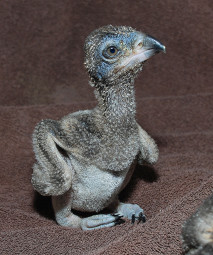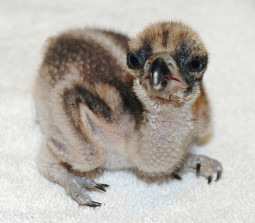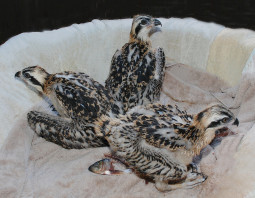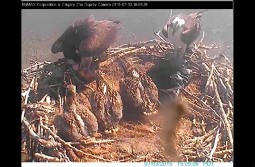
Creepy or cute, this newly-hatched osprey chick gets a big reaction from students.
When I visit Grade 2 classrooms to talk about ospreys, there is always debate about this picture. The students are usually split pretty evenly: half think the newly hatched chick is creepy looking and the other half insist it’s cute. Before the discussion deteriorates to an argument, though, we can generally all agree that osprey chicks look very different from their parents for the first couple of weeks.

Osprey chick a few days old.
I’ve never seen a baby dinosaur, but I imagine it would look a lot like a newly-hatched osprey chick. It’s scrawny and floppy and its skin is more nubbly than feathered. The chick’s eyes open in the first few hours after hatching. For the first week or so, it won’t have feathers, but will be covered with a soft, tan-coloured down.
When the chick is 10 – 12 days old, the down is replaced by a thick covering of black, woolly feathers. Its legs are greyish blue and the small, sharp claws at the end of each talon are black.

Three young osprey chicks.

Feathers beginning to poke through.
The osprey chicks in the nest near the Calgary Zoo are almost a month old now. The eggs were laid April 29, May 2, and May 5, and hatched on June 7, 8, and 10. Their flight feathers are

Osprey family in nest near the Calgary Zoo, July 3, 2015 (via Enmax webcam)
growing in and they look more like their parents, though their colouring is more mottled. That colouring is great camouflage from airborne predators, such as eagles. At the first sign of danger, the chick will sink down into the bowl of the nest and play dead, its mottled feathers helping it to blend into the sticks and grasses woven into the nest.
They will continue to grow quickly, and in a couple more weeks should be 70 – 80% of an adult’s weight. Three chicks eat a lot – about 2.7 kg (6 lbs) of fish a day! In July, watch as the chicks often flap their wings energetically, strengthening their muscles for the next milestone in their development: the first flight.
